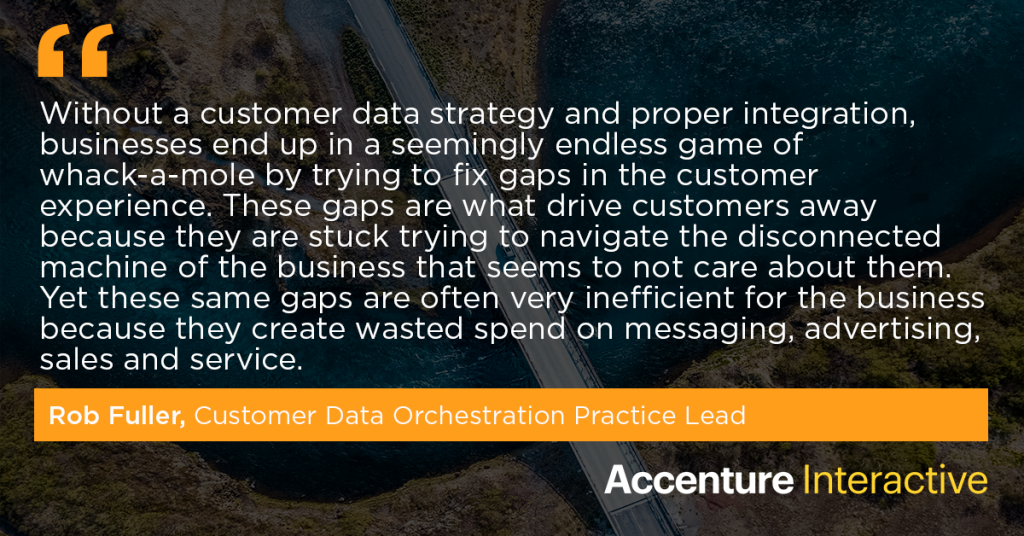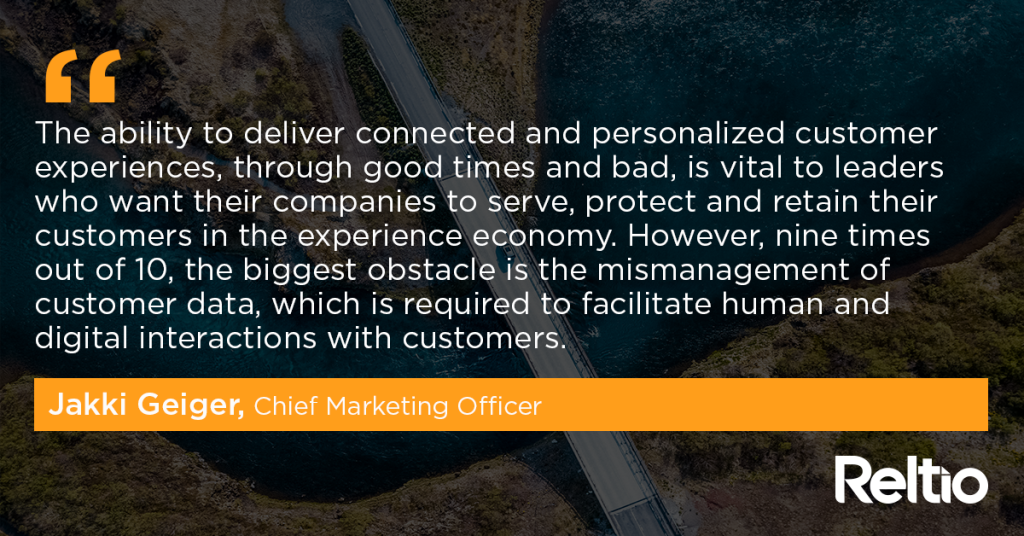Overcoming Obstacles to Connected Customer Experiences

Business leaders at Global 2000 companies are guiding their companies through uncharted territory during this time of great uncertainty. What’s encouraging is many are continuing to invest in improving digital engagement. Building personalized and connected customer experiences is more important than ever. They want to be there for their customers through good times and bad and they are focused on serving, protecting and retaining their customers.
But delivering personalized, connected customer experiences across all touchpoints is hard. In the first of this three-part blog series, The 4 Keys to Architecting the Connected Customer Experience we discussed the evolving role of data in the experience economy and the four keys to bridging the gaps in disconnected customer experiences. In this post, we’ll provide guidance on how to overcome the biggest obstacles to connected customer experiences in these current times of crisis and beyond. We focus on the impact of C-Suite, departmental and application disconnects on customer data.
The Disconnect that Starts in the C-Suite
The ability to deliver connected and personalized customer experiences, through good times and bad, is vital to leaders who want their companies to serve, protect and retain their customers in the experience economy. However, nine times out of 10, the biggest obstacle is the management of customer data, which is required to facilitate human and digital interactions with customers. Customer data often isn’t aligned across departments or applications, which leads to disconnected experiences and disappointing business results.
While the front-line staff often must deal with customers’ frustrations about disconnected experiences, often the disconnect starts in the C-Suite. Unless the executives in the C-Suite value all forms of customer data, they often fail to turn customer data into a company asset. What’s often missing is a strategic vision that aligns the departments and systems. And, a strategic vision for how customer data is managed at global 2000 companies is needed now more than ever.

Let’s take a look at what typically happens in the C-Suite at large and complex companies. The chief marketing officer (CMO), chief digital officer, chief customer officer, chief information officer (CIO) will each have their own mandates. They tend to be focused on their own organizational goals, strategies and plans. Of course, the most important person to any business is the customer. Without customers there is no business. Yet, often there is no one individual who’s goals, strategies and plans focus on the customer. And, often no one responsible is for the company-wide customer data required to deliver connected and personalized customer experiences across digital and human touchpoints.
Key Questions to Overcome C-Suite Disconnects
Leaders who believe customers should be at the center of their universe, and that customer data should be managed like a company asset, can help bridge these gaps. This process starts at the top with the C-Suite executives creating a vision for customer data. The vision translates into a customer data strategy and plan. It cascades throughout the organization through an understanding of the business requirements for customer data to power cross-functional processes, departmental processes and applications. It also impacts the requirements for the data management technology required to manage customer data as a company asset. The customer-focused leaders can ensure the right stakeholders are invited to strategy and planning discussions about digital engagement and customer experience initiatives. They can help facilitate collaboration and discussion between teams.
and customer experience initiatives. They can help facilitate collaboration and discussion between teams.
Here are some fundamental questions that can begin to bridge the disconnected data gap in the C-Suite:
- Are the interests of the customer at the heart of everything we do?
- Are we aligned on the value we deliver to our customers?
- Are we aligned on the trust we must uphold with the data we collect, manage and store about our customers?
- What customer data is important to share to create a frictionless customer experience across digital and human touchpoints?
- What can we do at this time of crisis to enable us to help our customers right now and what data do we have, or do we need to serve, protect and retain our customers?
Departmental Disconnects Negatively Impact Customer Experience
While customer data is critical to each department, and to the business at large, oftentimes there isn’t any alignment around it. Each department captures their own customer profile and only integrates with others as required to achieve a specific business objective.
For example, in many cases, customer experience strategies and plans are developed without data leaders in the room. A complete user-interface may be designed without thinking about the customer data and where the data will come from when a customer wants to sign up or log on. Or the product team builds a great new app, which generates a lot of valuable customer data, but they don’t involve the data leader to determine how this new source of valuable customer data should be managed and how it can be turned into a valuable asset for the company.
Whatever the scenario, too often, the data team is excluded entirely from key initiatives, particularly those focused on customer experience, digital experience, marketing and sales. Not surprisingly because of this, customer data is an afterthought in the process of building connected and personalized customer experiences.
Disconnected Applications Lead to Disconnected Customer Experiences
There tend to be fundamental gaps in how individuals within each department understand and manage data, with little if any collaboration. Across departments and floors, from the C-Suite down, different teams work with their own disconnected applications and data.
- Sales teams use a CRM platform and numerous other sales applications.
- Marketing uses the CRM platform, a separate marketing automation platform, numerous other marketing applications, and possibly a customer data platform (CDP) to support marketing segmentation, activation and analytics programs.
- Customer service uses customer service, help desk or contact center applications as well as many other product or channel-specific applications to understand the holistic customer relationship and history.
While these applications may be the best applications on the market, they aren’t designed to present a connected view of customer data. Because they only offer an application-centric view of customer data, they present a fragmented view of the customer.
Here are two typical examples of the impact of these gaps:
- The marketing team doesn’t have a complete, connected, real-time customer profile for segmentation, including cross-channel purchases and returns, so they send a loyal customer an offer for something they just purchased, is out of stock, or is no longer available in their size.
- The customer services representative doesn’t have visibility into the total customer relationship across product lines and channels. They must put the customer on hold several times while the search for information in different systems. Or the rep must ask the customer to repeat their full account information and problem because they were transferred from department to department.
Disconnected Data Leads to Disconnected Customer Experiences
Here are five typical misconceptions about customer data:
- Customer data is owned by one department or only applies to a couple of departments.
- Data should be treated as an afterthought.
- Customer experience teams should focus all their time on building beautiful user interfaces.
- Data or technical teams responsible for customer data don’t need to be invited to strategy and planning discussions for digital and customer experience initiatives.
Another key point is the requirements for customer data have grown exponentially over the last five years. Out-of-date data does not help the front line meet the needs of customers at the point of engagement and it degrades the digital experience at the experience team spent countless hours designing. Real-time data is needed to power both human and digital interaction. The data strategies and data management technologies of yesteryear are no longer meeting requirements.
A big problem arises when the data team is excluded from the digital engagement and customer experience strategy and planning discussions. Without real-time connected customer data, these initiatives won’t deliver on their full potential. At their worst, these major investments have a negative impact on customers and the business.
For example, by having a user interface redesigned without customer data considered in the design process, customers may encounter a new interface that causes confusion. It may present irrelevant content and offers. It may neglect to honor their preferences that are stored in other systems, and so on. Ultimately, despite significant investments, the customer experience can be degraded rather than improved.
Bridging the Gaps in the Disconnected Customer Experience
How do you serve, protect and retain your customers now and in the future?
Customers expect you to:
- Serve them with hyper-personalized and connected human and digital interactions based on a real-time understanding of their relationship with the brand
- Protect them by respecting privacy laws, and their consent and communication preferences
- Retain them by delivering innovative products and services and loyalty-building experiences
If data initiatives are disconnected across departments, the organization can’t deliver connected customer experiences. Data can’t be disjointed if teams are to realize their goals of fostering personalization, while adhering to privacy rules, consent, and customer preferences. A responsive customer data strategy that delivers real-time, connected customer data to power hyper-personalized and connected customer experiences is needed by customers and the front-line staff who support them in good times and bad.
It is time to rethink your customer data strategy.

Connected Customer Data is at the Heart of Connected Experiences
Now more than ever, the C-Suite should invest time in getting aligned on a vision for how customer data is managed as a company asset to be more responsive to customers in troubled times and beyond.
It is time to look at the process level and at the data layer to identify the cross-functional customer data needs to deliver connected experiences across the company.
A strategic company-wide approach creates alignment around the connected customer data that is vital for delivering hyper-personalized and connected experiences that can scale and span all their interaction channels. It can include:
- Arming staff and processes with the real-time data and insights needed to take proactive measures to tailor and enhance each human and digital interaction.
- Empowering all employees that have an impact on the customer experience to work from real-time, complete and cross-functional data.
- Enabling teams from across the organization to consistently and efficiently address compliance requirements, customer consent and communication preferences.
- Establishing transparency as a competitive advantage, helping teams more clearly communicate with customers about how data is being shared, used and managed; and to more intelligently align their policies and approaches with the specific preferences of each user.
The payoff of these efforts can be huge: The companies that get this right will have the up-to-date customer information that is vital in order to serve, protect and retain customers. As the global situation improves it could also give them a major advantage in their markets.
What’s next?
Watch this 30-minute on-demand webinar with Robert Fuller, Customer Data Orchestration Practice Lead at Accenture Interactive and Jakki Geiger, CMO of Reltio.
You will learn:
- How customer data management requirements have radically changed
- CDP & MDM technologies, how they differ and how they complement each other
- The 4 keys to bridge the gaps the disconnected customer experience

